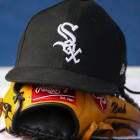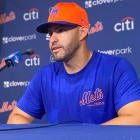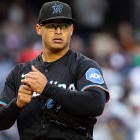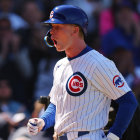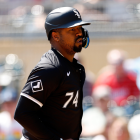With the regular season concluding, we've decided to take a look at each team's future -- not by using a crystal ball or other psychic abilities, but by evaluating their farm systems. Below you'll find our ranking of the top five prospects in the organization -- sorted by perceived future potential -- as well as five other players who fit various categories. Those categories are:
2020 contributor: A player who is likely to play a role for the big-league team next season.
Analyst's pick: A player who is a strong statistical performer and/or whose underlying measures are better than the scouting reports suggest.
Riser: A player on the way up.
Faller: A player on the way down.
One to watch: An interesting player to keep in mind (for whatever reason).
These rankings were compiled after talking with various industry sources about the systems (and players) in question. It should be acknowledged that this process is more art than science, and that there are limits to ordinal rankings. Still, it's an intuitive system, and our hope is that the write-ups will answer any questions by providing additional context and analysis of each player -- such as their pluses and minuses; the risk factors involved; and their estimated arrival date.
One last word on eligibility: we're following MLB's rookie guidelines by disqualifying any player with more than 130 big-league at-bats or 50 innings pitched.
The Chicago White Sox have one of the best systems in baseball as it pertains to their top five thanks to the drafting of Andrew Vaughn and the development of Jonathan Stiever. The White Sox figure to graduate at least three of their top five this year, but there is some intriguing talent beyond those five worth knowing about.
1. Luis Robert, OF
If you enjoyed the Eloy Jimenez service-time debates then go ahead and purchase a mass quantity of popcorn because the same arguments will resurface in spring about Luis Robert.
Robert spent 47 games in Triple-A, hitting .297/.341/.634 with 16 home runs and seven stolen bases. Across three levels, he combined to homer 32 times and steal 36 bags. Keep in mind: he only turned 22 in August. The White Sox elected against promoting him in September, meaning his debut might be delayed into next summer if Chicago intends to game his arbitration clock.
Robert has the potential to be a middle-of-the-order hitter who can hang in center field during the early stages of his career. The one concern here is his approach, as he walked in about five percent of his plate appearances this season -- that versus a strikeout rate closer to 24 percent.
Obviously it's possible more time in the minors could help Robert improve upon his strikeout-to-walk ratio. But there's a case to be made that -- given his success against minor-league pitchers -- further development will require a step up in competition. Come spring the White Sox will vote on what they believe -- or what they prioritize, anyway.
2. Michael Kopech, RHP
The most well known name on the list due to his inclusion in the Chris Sale trade, Michael Kopech made four big-league appearances in 2018. He struck out 15 batters in those 14 innings before succumbing to Tommy John surgery that ended his season and wiped out his 2019, too.
Kopech ranks here based on the expectation that he'll make a full recovery from the elbow operation. That means he returns with an elite fastball, two high-quality secondaries and the improved command he showed during the second half of 2018.
Perhaps Kopech doesn't have all that, at least not right away -- command is said to be the aspect that comes back last -- but for now his upside remains ace-like.
3. Andrew Vaughn, 1B
Andrew Vaughn the player is straightforward. He's a relentless worker who turned himself into arguably the best hitter in college baseball -- seriously, he hit .374/.539/.704 with nearly twice as many walks as strikeouts. There's a fair chance he'll be batting in the top four of a big-league lineup in 12 to 16 months' time, after which he should be a well-rounded, above-average hitter.
Vaughn the idea is less straightforward. He's an ex-collegiate first baseman who bats righty, stands under six feet, and was drafted No. 3 overall. The track record of similar players isn't very good, to the extent that there was some thought about trying him at third base. The White Sox don't seem too interested in that idea, having played him exclusively at the cold corner. It's probably for the best, since Vaughn's best position is (and always will be) in the batter's box.
Vaughn hit .278/.348/.449 in his first 245 professional plate appearances. He might begin the year at Double-A with an outside shot at debuting as Jose Abreu's heir late in the season.
4. Nick Madrigal, 2B
The No. 4 pick in the 2018 draft, Nick Madrigal is unlike most any other player in baseball. He's small and unlikely to offer much power, yet he's a good defensive second baseman with absurd bat-to-ball skills who "runs like a [mother's intimate friend]," in the words of one source.
Madrigal has walked 30 more times than he's struck out in his career, which is impressive considering he's fanned all of 21 times -- or in less than three percent of his trips to the plate. For reference, no qualified hitter in the majors has struck out less than nine percent of the time this year. In fact, just 13 batters have checked in since the last round of expansion with more than 300 plate appearances and a K rate below five percent. The last person to do it was Jeff Keppinger, back in 2008. (The lowest since 2010 is 5.8 percent, by Juan Pierre in 2011.)
Madrigal has, perhaps predictably, moved quickly through the system. He reached Triple-A for a 29-game stretch this season, hitting .331/.398/.424 and positioning himself to debut in the majors early next year. Interestingly, he pulled the ball far more often than he had previously as a professional, when he'd been primarily an opposite-field hitter. He'll need to do both heading forward -- and his ability to do so could help him win a batting title some day.
A profile this unusual is either going to sink or swim. Here's hoping Madrigal swims -- Lord knows baseball can always benefit from something (or someone) a little different.
5. Jonathan Stiever, RHP
The true riser in the system, Jonathan Stiever went from being a fifth-round pick via Indiana University to having his teammates call him "Verlander" in honor of his similarities with the Astros ace in just over a year's time.
At least one team asked for Stiever around the trade deadline -- ostensibly hoping the White Sox were asleep at the wheel -- and it's easy to see why. He's an athletic right-hander with the requisite size and control to start. His arsenal includes a fastball that can bump into the upper-90s and features good carry, and a high-quality curveball that plays well off it.
The White Sox pushed Siever to High-A for his final 12 starts and he responded with a 2.15 ERA and a 5.92 strikeout-to-walk ratio. He figures to spend his time in Double-A this year, but it may not be too long until he joins Kopech and Dylan Cease in Chicago's rotation.
2020 contributor: Codi Heuer, RHP
Codi Heuer is a crossfire slinger who saw his strikeout rate drop once he moved up to Double-A. He gets the nod here due to romanticism: who doesn't yearn for the groundball specialist to return? Heuer, for his part, could someday play the part. He coerced more than 60 percent grounders in 2019, per FanGraphs, and didn't yield a home run in 67 innings. He should open the season in the high minors, but could finish it in Chicago.
Analyst's pick: Gavin Sheets, 1B
At 6-foot-4 and 230 pounds, Gavin Sheets looks like he should be a slugger. But the former Wake Forest first baseman is still trying to learn to tap into his power. There were signs of progress in 2019 -- namely, he posted a career-high .147 ISO and hit 16 home runs in Double-A after having hit just 10 home runs in his first 175 games. If Sheets can summon the boom stick more often, he has the contact and on-base skills to have a big-league career.
Riser: Steele Walker, OF
A second-round pick in 2018, the debonair Steele Walker spent most of the season in High-A. He hit for some average, reached base a fair amount and provided some pop -- in other words, he pitched in a little bit of everything. That's his way forward, as he's a portfolio player who lacks a true carrying tool. He has a fair chance at being a starter when all is said and done.
Faller: Alec Hansen, RHP
Remember when Alec Hansen looked like a draft steal? Things went off the rails in 2018, and a move to the bullpen this season didn't help him recover. Instead, Hansen walked 44 batters in 52 innings across High- and Double-A. He's a large lad, listed at 6-foot-7, with a deliberate delivery that features a lot of moving parts and results in poor control. Dellin Betances walked seven per nine in the minors during his age-24 season, and he turned out quite all right. But the odds are very much working against Hansen enjoying any kind of big-league success anymore.
One to watch: Luis Alexander Basabe, OF
Part of the Chris Sale payout, Luis Alexander Basabe is a good athlete who needs further refinement if he's to max out as a defender and baserunner (he's a career 73 percent thief). He's perhaps best known for homering on a 102 mph fastball in the 2018 Futures Game, yet his power was sapped this season after he broke his left hamate bone in the spring. Basabe walks a lot, but he's going to need to regain his power stroke to offset his strikeout tendencies. If he does, he could reach the majors later in the year, thereby forming an impressive young outfield.













